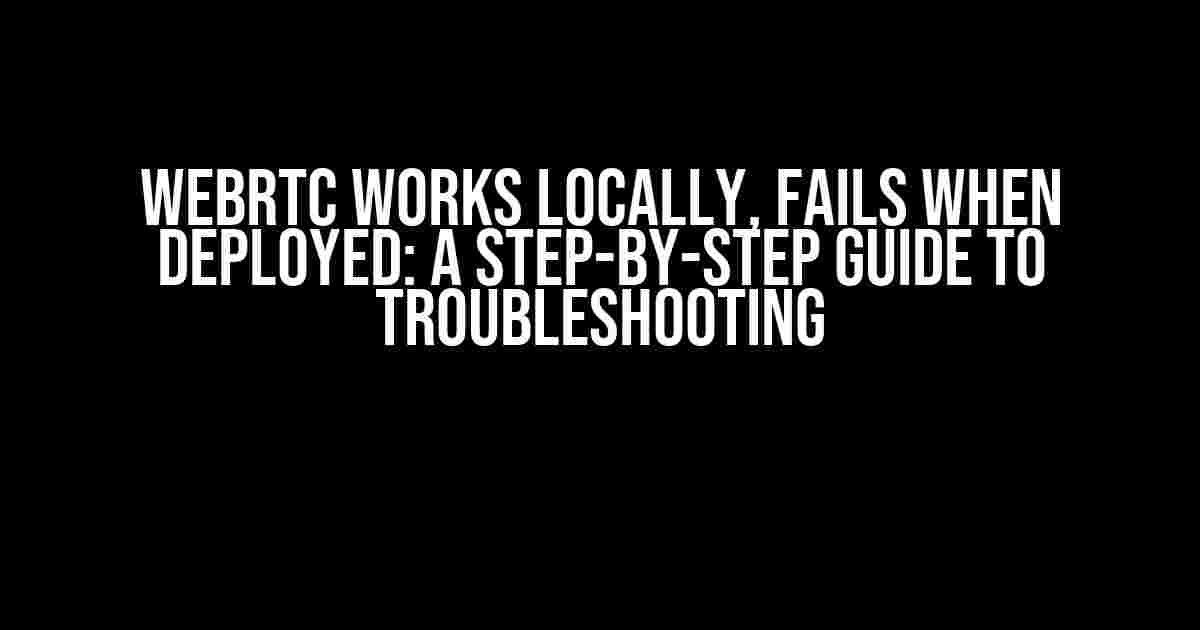If you’re reading this, chances are you’re frustrated. You’ve spent hours, maybe even days, building a WebRTC application that works flawlessly on your local machine. But the moment you deploy it, it fails to deliver. Sounds familiar? Don’t worry, you’re not alone. In this article, we’ll delve into the mysteries of WebRTC and provide you with a comprehensive guide to troubleshoot and resolve the issues that are preventing your application from working in a production environment.
Understanding WebRTC
Before we dive into the troubleshooting process, let’s take a step back and understand how WebRTC works. WebRTC (Web Real-Time Communication) is an API that enables real-time communication between browsers. It’s a complex technology that involves multiple components, including:
- PeerConnection: Establishes a connection between two browsers
- UserMedia: Accesses the user’s camera and microphone
- DataChannel: Enables the transfer of data between browsers
- Signaling: Facilitates communication between browsers to establish a connection
The Problem: WebRTC works locally, fails when deployed
So, what’s going on? Why does your WebRTC application work seamlessly on your local machine but fail when you deploy it? There are several reasons for this, including:
- Firewall and network restrictions
- SSL/TLS certificates and HTTPS
- TURN/STUN server configuration
- Browser and device compatibility issues
- Server-side implementation and configuration
Troubleshooting: A Step-by-Step Guide
Now that we’ve identified some potential culprits, let’s go through a step-by-step process to troubleshoot and resolve the issues.
Step 1: Check the Browsers and Devices
Ensure that you’re using the latest versions of Chrome, Firefox, or Edge (or any other browser that supports WebRTC). Also, test your application on multiple devices and browsers to isolate the issue.
Step 2: Verify SSL/TLS Certificates and HTTPS
WebRTC requires a secure connection, so make sure you have:
- A valid SSL/TLS certificate installed on your server
- HTTPS enabled on your domain
- The certificate is configured correctly for WebRTC
// Example of a correctly configured SSL/TLS certificate
const rtcConfig = {
iceServers: [
{
urls: 'stun:stun.l.google.com:19302',
credential: 'your-username',
username: 'your-password'
}
],
tls: true
};
Step 3: Configure TURN/STUN Servers
TURN (Traversal Using Relays around NAT) and STUN (Session Traversal Utilities for NAT) servers help facilitate communication between browsers behind different networks. You can use public TURN/STUN servers or set up your own.
| Server | URL | Port |
|---|---|---|
| Google STUN Server | stun.l.google.com:19302 | 19302 |
| XirSys TURN Server | your-turn-server.xirsys.com | 3478 |
// Example of configuring TURN/STUN servers
const turnServer = {
urls: 'turn:your-turn-server.xirsys.com:3478',
credential: 'your-username',
username: 'your-password'
};
const stunServer = {
urls: 'stun:stun.l.google.com:19302'
};
const iceServers = [turnServer, stunServer];
Step 4: Check Firewall and Network Restrictions
Firewalls and network restrictions can block WebRTC traffic. Ensure that:
- Your firewall allows outgoing traffic on the required ports (e.g., 3478 for TURN)
- Your network allows WebRTC traffic (check with your network administrator)
Step 5: Review Server-Side Implementation and Configuration
Verify that your server-side implementation is correctly configured for WebRTC. Check:
- Server-side signaling implementation (e.g., socket.io, WebSocket)
- WebRTC API implementation (e.g., PeerConnection,getUserMedia)
- Server-side error handling and logging
// Example of server-side signaling implementation using socket.io
const io = require('socket.io')(server);
io.on('connection', (socket) => {
console.log('Client connected');
// Handle signaling messages
socket.on('signal', (signal) => {
console.log('Signal received:', signal);
// Handle signal message
});
});
Step 6: Test and Debug
Test your application thoroughly, and use debugging tools like the Chrome DevTools or Firefox Developer Edition to identify issues.
// Example of using Chrome DevTools to debug WebRTC
console.log(pc.getLocalStreams()); // Get local streams
console.log(pc.getRemoteStreams()); // Get remote streams
// Use the Chrome DevTools to inspect the PeerConnection object
console.log(pc);
Conclusion
Troubleshooting a WebRTC application that works locally but fails when deployed can be a daunting task. However, by following this step-by-step guide, you should be able to identify and resolve the issues preventing your application from working in a production environment. Remember to stay calm, be patient, and don’t hesitate to seek help when needed.
By implementing these troubleshooting steps, you’ll be well on your way to building a robust and reliable WebRTC application that works seamlessly in any environment. Happy coding!
Frequently Asked Question
WebRTC got you going in circles? Don’t worry, we’ve got the answers to your most pressing questions!
Why does WebRTC work locally but fail when I deploy it?
This is a classic symptom of a mismatch between your development and production environments. When you deploy your WebRTC application, it’s likely that the network configuration and firewall rules change, blocking the necessary ports and protocols. Double-check your deployment setup to ensure that WebRTC traffic is allowed.
Is it because of CORS issues?
You’re getting warm! CORS (Cross-Origin Resource Sharing) is a common culprit when WebRTC works locally but not in production. Make sure you’ve enabled CORS on your server and that the necessary headers are set. You can also try using a proxy server to circumvent CORS restrictions.
Could it be related to STUN and TURN servers?
You’re on the right track! STUN (Session Traversal Utilities for NAT) and TURN (Traversal Using Relays around NAT) servers are essential for WebRTC to work across different networks. If you’re not using a STUN/TURN server or if it’s not properly configured, your WebRTC app might fail in production. Double-check your STUN/TURN server setup and ensure it’s accessible from your deployment environment.
What about SSL/TLS certificates?
SSL/TLS certificates can also cause issues if not properly configured. WebRTC requires a secure connection to function, so ensure that your SSL/TLS certificates are valid, properly configured, and trusted by the browsers and devices you’re targeting.
Are there any browser-specific issues I should look out for?
You bet! Each browser has its quirks and limitations when it comes to WebRTC. For example, Safari requires additional configuration for WebRTC to work, while Firefox has specific requirements for SSL/TLS certificates. Research the specific browser(s) you’re targeting and ensure you’re meeting their WebRTC requirements.







